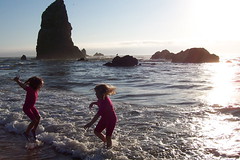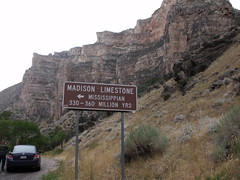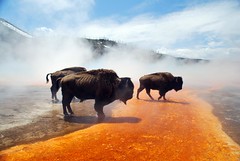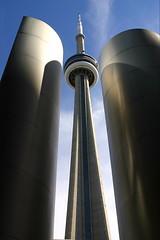Here's a second blog post about some of the places I've been that I recommend—some natural, some artificial, in rough order from nearest to farthest from my house. Go back to read part 1 or check out part 3 if you like.
 My wife introduced me to Cannon Beach, Oregon in the 1990s. Near the northwest tip of that state's famous Pacific coast, it's a somewhat pricey tourist town for a good reason, with a long, stunning sandy beach punctuated by offshore seastacks and the imposing monolith of Haystack Rock. We've taken the kids there on family summer vacations four times since they were born, starting when our younger daughter was only a few months old. From Vancouver, we can reach it in a day by car, either via Portland or via the Columbia River and Astoria—in many ways it's easier to get there than to the also-wonderful Long Beach near Tofino on Vancouver Island, since there's no ferry and better roads. I hope we can visit Cannon Beach at least once more, like we did Tofino last year.
My wife introduced me to Cannon Beach, Oregon in the 1990s. Near the northwest tip of that state's famous Pacific coast, it's a somewhat pricey tourist town for a good reason, with a long, stunning sandy beach punctuated by offshore seastacks and the imposing monolith of Haystack Rock. We've taken the kids there on family summer vacations four times since they were born, starting when our younger daughter was only a few months old. From Vancouver, we can reach it in a day by car, either via Portland or via the Columbia River and Astoria—in many ways it's easier to get there than to the also-wonderful Long Beach near Tofino on Vancouver Island, since there's no ferry and better roads. I hope we can visit Cannon Beach at least once more, like we did Tofino last year. Take the Trans-Canada Highway or the Canadian Pacific Railway east from Vancouver, into the Selkirk Mountains, and you reach the Continental Divide at Rogers Pass. Depending on the weather, you might not see much, or you might gasp at the peaks overhead. Whether going by road or rail, you'll pass through tunnels and snowsheds, and by train you'll cross over deep gorges via astonishing bridges. In winter, the pass region features one of the most extensive avalanche control programs in the world, where Canadian military guns blast dangerous snow accumulations off the slopes to prevent deadly slides. Even if you're passing through on the way elsewhere, don't forget to look up.
Take the Trans-Canada Highway or the Canadian Pacific Railway east from Vancouver, into the Selkirk Mountains, and you reach the Continental Divide at Rogers Pass. Depending on the weather, you might not see much, or you might gasp at the peaks overhead. Whether going by road or rail, you'll pass through tunnels and snowsheds, and by train you'll cross over deep gorges via astonishing bridges. In winter, the pass region features one of the most extensive avalanche control programs in the world, where Canadian military guns blast dangerous snow accumulations off the slopes to prevent deadly slides. Even if you're passing through on the way elsewhere, don't forget to look up. Conversely, if you drive west across the northern U.S. along the I-90 freeway, there is a point in Wyoming where the Interstate veers north, skirting the Rocky Mountain foothills. Near Ranchester, you can leave the I-90 and take Highway 14 west again into those foothills, and then up the steep, imposing escarpment beyond Dayton, where the switchbacks take you from 4000 feet of altitude to 7500 feet over only a few dozen miles of road, between Steamboat Point and Horseshoe Mountain. (Make sure your car can handle it.) From time to time, roadside signs tell you the age and type of rocks you're driving past, and you can stop at occasional pullouts to admire the view of the parched landscape you just climbed out of. When I read those signs in 1991, I noticed something: as my friend Andrew and I drove higher and higher in my parents' borrowed station wagon, the rocks were getting younger. In forming the Rockies and more over tens of millions of years, geological processes have not only thrust up the huge mountain ranges of western North America, in the process they flipped the land over like a continental omelette. Holy crap.
Conversely, if you drive west across the northern U.S. along the I-90 freeway, there is a point in Wyoming where the Interstate veers north, skirting the Rocky Mountain foothills. Near Ranchester, you can leave the I-90 and take Highway 14 west again into those foothills, and then up the steep, imposing escarpment beyond Dayton, where the switchbacks take you from 4000 feet of altitude to 7500 feet over only a few dozen miles of road, between Steamboat Point and Horseshoe Mountain. (Make sure your car can handle it.) From time to time, roadside signs tell you the age and type of rocks you're driving past, and you can stop at occasional pullouts to admire the view of the parched landscape you just climbed out of. When I read those signs in 1991, I noticed something: as my friend Andrew and I drove higher and higher in my parents' borrowed station wagon, the rocks were getting younger. In forming the Rockies and more over tens of millions of years, geological processes have not only thrust up the huge mountain ranges of western North America, in the process they flipped the land over like a continental omelette. Holy crap. Keep following Highway 14 and you'll climb up over 9000 feet above sea level, then down, then up again, along valleys and canyons until eventually you reach the remarkable caldera of Yellowstone National Park. You might feel a bit nervous knowing that you're standing on a potential supervolcano, but you'll also be seeing stuff you don't anywhere else: not only the famous geysers, hot pools, prismatic springs, and ever-changing hydrothermal formations, but also abundant and often fearless wildlife (including bison, bears, moose, elk, cougars, and wolves), and forest ecosystems recovering from recent fires. At night, as at Crater Lake in Oregon, the altitude and distance from cities give you an extraordinary view of the starry sky.
Keep following Highway 14 and you'll climb up over 9000 feet above sea level, then down, then up again, along valleys and canyons until eventually you reach the remarkable caldera of Yellowstone National Park. You might feel a bit nervous knowing that you're standing on a potential supervolcano, but you'll also be seeing stuff you don't anywhere else: not only the famous geysers, hot pools, prismatic springs, and ever-changing hydrothermal formations, but also abundant and often fearless wildlife (including bison, bears, moose, elk, cougars, and wolves), and forest ecosystems recovering from recent fires. At night, as at Crater Lake in Oregon, the altitude and distance from cities give you an extraordinary view of the starry sky. I've written before about the appeal of the American Southwest deserts, and their focus is, of course, the Grand Canyon. Some places are less impressive than legend makes them out to be (giant Redwood and Sequoia forests in California, for me, since they're much like groves I can walk to from my house), some are exactly as you might expect (Mount Rushmore, which was pretty much as big as I thought, but no bigger), and some are far more impressive than you can imagine in advance. The Grand Canyon is one of those. Yes, that's a cliché, but because it's true. You won't get an idea of the place until you go, and you should. While you're in the area, visit Bryce Canyon and Zion National Park in nearby Utah too—wonderful and beautiful in their own way, but not on the same scale.
I've written before about the appeal of the American Southwest deserts, and their focus is, of course, the Grand Canyon. Some places are less impressive than legend makes them out to be (giant Redwood and Sequoia forests in California, for me, since they're much like groves I can walk to from my house), some are exactly as you might expect (Mount Rushmore, which was pretty much as big as I thought, but no bigger), and some are far more impressive than you can imagine in advance. The Grand Canyon is one of those. Yes, that's a cliché, but because it's true. You won't get an idea of the place until you go, and you should. While you're in the area, visit Bryce Canyon and Zion National Park in nearby Utah too—wonderful and beautiful in their own way, but not on the same scale. No doubt there are more impressive caves in the world, but one amazing talent of Americans is making natural features accessible to regular people, and Carlsbad Caverns in New Mexico demonstrates that genius. You can, and should, hike into the massive cavern complex using a reasonably easy paved trail with railings, lighting, and benches to sit and rest. Or you can simply take a high-speed elevator 750 feet down into the Earth from the flat New Mexico desert (parking nearby)—at the bottom there is a restaurant and even a post office where you can mail letters to your friends and family from deep underground. Some of the Big Room is wheelchair accessible. If you did hike down, the elevator makes returning to the surface a breeze. Yet that doesn't detract from the spectacle of the formations, which are enhanced by coloured lights and explanatory plaques. I've been spelunking in less-developed caves, with flashlights and hardhats, and that has its own rewards. But at Carlsbad Caverns, you'll wonder at both the stalactites and the engineering effort that went into making it easy for you to see them.
No doubt there are more impressive caves in the world, but one amazing talent of Americans is making natural features accessible to regular people, and Carlsbad Caverns in New Mexico demonstrates that genius. You can, and should, hike into the massive cavern complex using a reasonably easy paved trail with railings, lighting, and benches to sit and rest. Or you can simply take a high-speed elevator 750 feet down into the Earth from the flat New Mexico desert (parking nearby)—at the bottom there is a restaurant and even a post office where you can mail letters to your friends and family from deep underground. Some of the Big Room is wheelchair accessible. If you did hike down, the elevator makes returning to the surface a breeze. Yet that doesn't detract from the spectacle of the formations, which are enhanced by coloured lights and explanatory plaques. I've been spelunking in less-developed caves, with flashlights and hardhats, and that has its own rewards. But at Carlsbad Caverns, you'll wonder at both the stalactites and the engineering effort that went into making it easy for you to see them. Since the jet-travel revolution of the 1960s, Hawaii has been a favourite destination for Vancouverites. In five hours or so, we can go from a wet and cold Vancouver winter to a tropical volcanic Pacific paradise that's still part of our neighbour the U.S.A. Yet I never visited it until 2006, when I was 37 years old. Hawaii includes many wonders, but I missed some of the most spectacular, such as eruptions on the Big Island or the crater of Haleakala—my family and I only saw Oahu, and even there the surf wasn't particularly large on the legendary North Shore. However, Pali Lookout was still something else. We have mountains here in British Columbia, and sometimes crazy winds, but they don't come together like they do at Pali, a cliffside perch overlooking Windward Oahu on the east side of the island. A natural wind tunnel, it is one of the breeziest places I've ever been, yet the blast is warm, not freezing as it would be at home. The nearby sheer mountainsides are unlike anything in my home province, striated as they are by deep tropical erosion gullies and entirely coated in warm-climate vegetation. Despite its precarious spot, Pali Lookout is easy to drive to in a car or tour bus, being just off the Pali Highway.
Since the jet-travel revolution of the 1960s, Hawaii has been a favourite destination for Vancouverites. In five hours or so, we can go from a wet and cold Vancouver winter to a tropical volcanic Pacific paradise that's still part of our neighbour the U.S.A. Yet I never visited it until 2006, when I was 37 years old. Hawaii includes many wonders, but I missed some of the most spectacular, such as eruptions on the Big Island or the crater of Haleakala—my family and I only saw Oahu, and even there the surf wasn't particularly large on the legendary North Shore. However, Pali Lookout was still something else. We have mountains here in British Columbia, and sometimes crazy winds, but they don't come together like they do at Pali, a cliffside perch overlooking Windward Oahu on the east side of the island. A natural wind tunnel, it is one of the breeziest places I've ever been, yet the blast is warm, not freezing as it would be at home. The nearby sheer mountainsides are unlike anything in my home province, striated as they are by deep tropical erosion gullies and entirely coated in warm-climate vegetation. Despite its precarious spot, Pali Lookout is easy to drive to in a car or tour bus, being just off the Pali Highway. The CN Tower in Toronto was never the tallest artificial thing in the world, but for more than 30 years it was the tallest freestanding structure—one that doesn't need guy wires or the buoyancy of water to keep it up. It's still taller than any occupied building in the Western Hemisphere. Given the rate at which new supertall buildings and towers are now being built, it's unlikely any of them will hold the title for that long. The CN Tower is not an especially pretty thing, especially close up with its vast buttresses of concrete, but it has an Apollo-era Tomorrowland rocket vibe that newer competitors don't emulate. While visiting my parents in Toronto when they lived there, I once went to the bar and ordered a 7-Up, which came in an appropriately tall and skinny glass. From the Sky Pod observation deck you can look out more than 100 miles over the flat expanse of Greater Toronto and across Lake Ontario to the United States. You can also visit the glass floor to look down at the city below your feet, and the outdoor observation deck to feel a high-altitude wind that only birds felt for millennia.
The CN Tower in Toronto was never the tallest artificial thing in the world, but for more than 30 years it was the tallest freestanding structure—one that doesn't need guy wires or the buoyancy of water to keep it up. It's still taller than any occupied building in the Western Hemisphere. Given the rate at which new supertall buildings and towers are now being built, it's unlikely any of them will hold the title for that long. The CN Tower is not an especially pretty thing, especially close up with its vast buttresses of concrete, but it has an Apollo-era Tomorrowland rocket vibe that newer competitors don't emulate. While visiting my parents in Toronto when they lived there, I once went to the bar and ordered a 7-Up, which came in an appropriately tall and skinny glass. From the Sky Pod observation deck you can look out more than 100 miles over the flat expanse of Greater Toronto and across Lake Ontario to the United States. You can also visit the glass floor to look down at the city below your feet, and the outdoor observation deck to feel a high-altitude wind that only birds felt for millennia. I never went inside the Chrysler Building during my one visit to New York City ten years ago, but that's no matter. Its gleaming metal spire with nested arches and triangle windows, Art Deco retro yet still vibrantly modern, "always looks like the future," in the words of Salon's Stephanie Zacharek back in 2002. Thankfully, no one so far has ever considered renaming it either. You can stand near the Empire State Building, like the CN Tower, and look up, saying to yourself, "Man, that's tall." But with the Chrysler Building, night or day, you say, "Man, that's beautiful." I wish Vancouver had even one skyscraper so pretty. Then again, even Manhattan has only the one.
I never went inside the Chrysler Building during my one visit to New York City ten years ago, but that's no matter. Its gleaming metal spire with nested arches and triangle windows, Art Deco retro yet still vibrantly modern, "always looks like the future," in the words of Salon's Stephanie Zacharek back in 2002. Thankfully, no one so far has ever considered renaming it either. You can stand near the Empire State Building, like the CN Tower, and look up, saying to yourself, "Man, that's tall." But with the Chrysler Building, night or day, you say, "Man, that's beautiful." I wish Vancouver had even one skyscraper so pretty. Then again, even Manhattan has only the one.
Next time, we'll go overseas.
